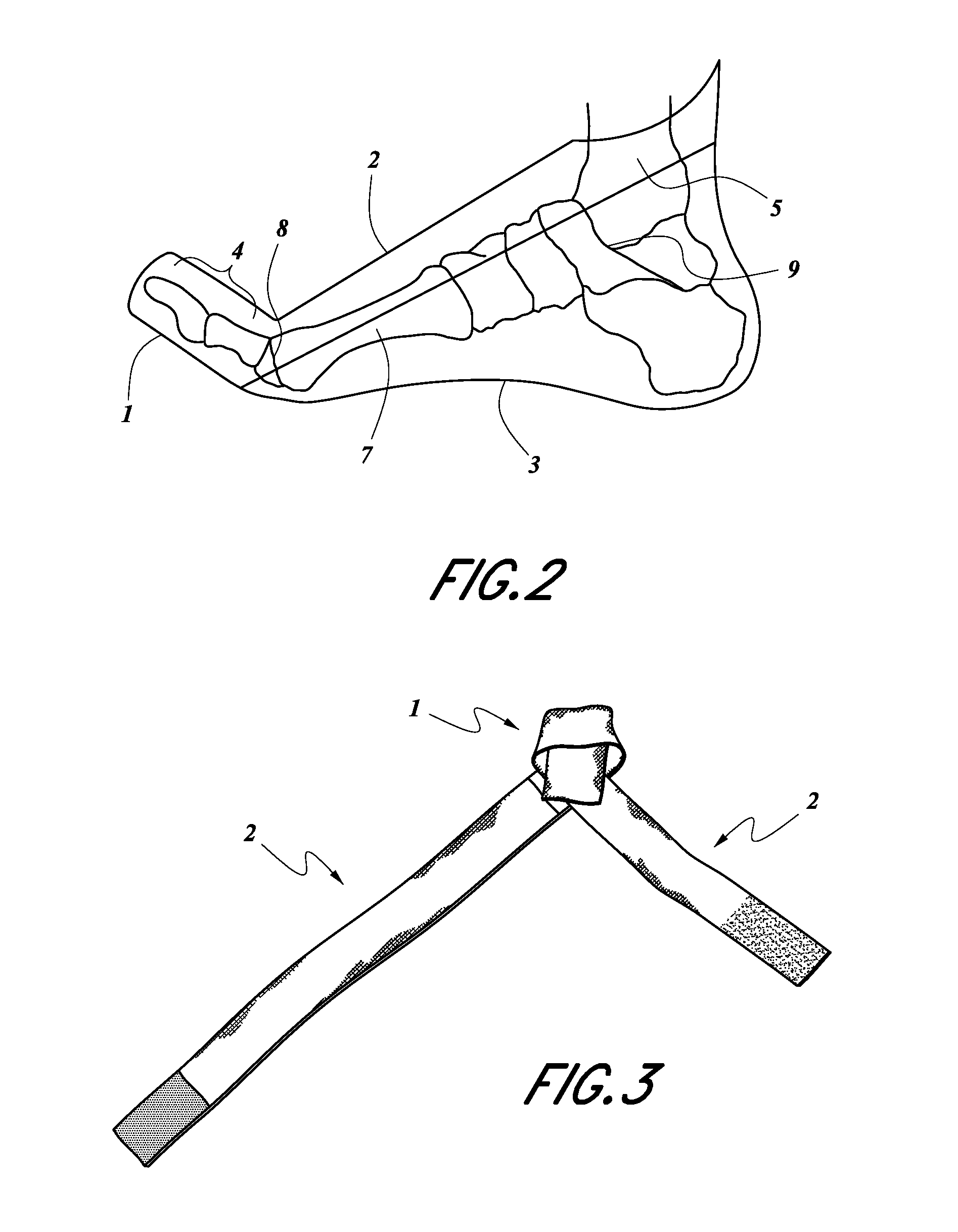Dynamic hallux tension device for treatment of plantar fasciitis
a technology of plantar fasciitis and tension device, which is applied in the field of physical rehabilitation device, can solve the problems of pain in the heel and/or metatarsal region, the static hallux dorsiflexion splint does not allow free, and is normally not a practical solution to plantar fasciitis, so as to improve the night treatment of plantar fasciitis, relieve the tension on the great toe, and control the amount of tension
- Summary
- Abstract
- Description
- Claims
- Application Information
AI Technical Summary
Benefits of technology
Problems solved by technology
Method used
Image
Examples
first embodiment
[0021]a dynamic tension device is illustrated in FIGS. 1-5 and 7 (medial view of device over the bones of the foot). The device utilizes a hallux sling 1 (FIG. 2), which is a stiff elastic band consisting of a nylon blend, although it is not limited to this material, wrapped around the plantar surface of the hallux 4 (FIG. 2). The second toe may also be included in the hallux sling 1 (FIG. 2).
[0022]The hallux sling 1 (FIG. 2) is secured to the posterior ankle 5 (FIG. 2) via the ankle sling 2 (FIG. 2). The ankle sling 2 (FIG. 2) is another stiff elastic band, which is composed of the same material as the hallux sling 1 (FIG. 2), although it may be composed of a different material. The ankle sling 2 (FIG. 2) is less stiff than the hallux sling 1 (FIG. 2) and is wrapped around the ankle 5 (FIG. 2).
second embodiment
[0023]the invention includes the first embodiment of the invention, in addition to a sock as shown in FIG. 6. Alternatively, the remainder of the dynamic tension device is filled in with a flexible material 3 (see e.g., FIG. 2), such as a cotton-blend, to mimic a sock, although it may be composed of another flexible material, or the remainder can be left empty based on the desired design and function.
[0024]The operation of the device is illustrated in the following FIGS. 1,3,4,5,6 and 7.
[0025]The device is simple in design. It is composed of a hallux (big toe) sling 1 made of an elastic band and cotton or other similar materials which is secured to itself by a VELCRO® hoop and loop fastener-or other similar material. The hallux sling 1 is in the form of a helix. A hallux sling 1 of the first embodiment of the invention, without a sock, is shown over a foot in FIG. 1.
[0026]A close view of the hallux loop (helix) of the device is shown in FIG. 7. As shown the helix can include a secon...
PUM
 Login to View More
Login to View More Abstract
Description
Claims
Application Information
 Login to View More
Login to View More - R&D
- Intellectual Property
- Life Sciences
- Materials
- Tech Scout
- Unparalleled Data Quality
- Higher Quality Content
- 60% Fewer Hallucinations
Browse by: Latest US Patents, China's latest patents, Technical Efficacy Thesaurus, Application Domain, Technology Topic, Popular Technical Reports.
© 2025 PatSnap. All rights reserved.Legal|Privacy policy|Modern Slavery Act Transparency Statement|Sitemap|About US| Contact US: help@patsnap.com



